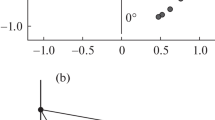Abstract
Needle electrodes were used to record action potentials of motor units of the rectus femoris muscle during isometric contraction (up to 50% of maximal). Up to 10 motor units working simultaneously could be identified. Under strictly stable conditions of muscular contraction the recruitment order of the motoneurons was constant. The firing rate was inversely proportional as a rule to this recruitment order. As a rule the changes in frequency connected with voluntary contraction of measured strength were in the same direction for different motoneurons. Statistical analysis of the frequency fluctuations observed during contraction of constant strength revealed direct correlation between them. The behavior of the motoneurons as described above is regarded as the result of the diffuse, indeterminate distribution of the synaptic input in the group of motoneurons innervating the muscle studied. It was also shown that even under stable conditions individual motoneurons or groups of them sometimes fired independently. During the performance of different types of movements, the firing rates of the recruited motoneurons varied in different directions and some motoneurons were replaced by others. This shows that when motoneurons function under natural conditions they use not only a common (indeterminate) but also a determinate input.
Similar content being viewed by others
Literature cited
E. V. Glivenko, T. A. Korol'kova, and G. D. Kuznetsova, "The integral picture of correlations between biopotentials in the rabbit cerebral cortex," Fiziol. Zh. SSSR,48, 384 (1962).
V. S. Gurfinkel', T. D. Surguladze, M. L. Mirskii, and A. M. Tarko, "The work of human motor units during rhythmic movements," Biofizika,15, 1090 (1970).
P. G. Kostyuk, "Neuronal organization of descending systems of the spinal cord," Mechanisms of Descending Control of Spinal Cord Activity [in Russian], Nauka, Leningrad (1971), pp. 148–153.
R. S. Person and L. P. Kudina, "Investigation of the firing rate of human motoneurons during voluntary contraction of a muscle," Neirofiziologiya,3 200 (1971).
A. I. Shapovalov, The Cellular Mechanisms of Synaptic Transmission [in Russian], Meditsina, Moscow (1966).
B. Ashworth, L. Grimby, and E. Kugelberg, "Comparison of voluntary and reflex activation of motor units," J. Neurol. Neurosurg. Psychiat.,30, 91 (1967).
J. V. Basmajian, MuscleAlive. Their Functions Revealed by Electromyography, Baltimore (1967).
C. G. Bernard and E. Bohm, "Cortical representation and functional significance of the corticomotoneuronal system," A.M.A. Arch. Neurol. Psychiat.,72, 473 (1954).
R. E. Burke, "Firing patterns of gastrocnemius motor units in the decerebrate cat," J. Physiol. (London),196, 631 (1968).
R. E. Burke, E. Jankowska, and G. ten. Bruggencate, "A comparison of peripheral and rubrospinal synaptic input to slow and fast twitch motor units of triceps surae," J. Physiol. (London),207, 709 (1970).
H. P. Clamann, "Activity of single motor units during isometric tension," Neurology,20, 254 (1970).
R. Granit, The Basis of Motor Control, London and New York (1970).
L. Grimby and J. Hannerz, "Recruitment order of motor units on voluntary contraction: changes induced by proprioceptive afferent activity," J. Neurol. Neurosurg. Psychiat.,31, 565 (1968).
V. F. Harrison and O. A. Mortensen, "Identification and voluntary control of single motor unit activity in the tibialis anterior muscle," Anat. Rec.,144, 109 (1962).
E. Henneman and C. B. Olson, "Relation between structure and function in the design of skeletal muscles," J. Neurophysiol.,28, 581 (1956).
E. Henneman, G. Somjen, and D. O. Carpenter, "Excitability and inhibitability of motoneurons of different sizes," J. Neurophsiol.,28, 599 (1965).
H.-J. Hufschmidt, "Zur funktionellen Organisation der motorischen Einheiten eines Muskels," Dtsch. Z. Nervenheilk.,178, 583 (1959).
D. Kernell, "The adaptation and the relation between discharge frequency and current strength of cat lumbo-sacral motoneurons stimulated by long-lasting injected currents," Acta Physiol. Scand.,65, 65 (1965).
D. P. C. Lloyd and A. K. McIntyre, "Transmitter potentiality of homonymous and heteronymous monosynaptic reflex connections of individual motoneurons," J. Gen. Physiol.,38, 789 (1955).
L. M. Mendell and E. Henneman, "Terminals of single Ia fibers: location, density and distribution within a pool of 300 homonymous motoneurons," J. Neurophysiol.,34, 171 (1971).
D. J. Mishelevich, "Repetitive firing to current in cat motoneurons as a function of muscle unit twitch type," Exptl. Neurol.,25, 401 (1969).
D. H. Perkel and T. H. Bullock, "Neural coding", Neurosci. Res. Symp. Summaries (Cambridge, Mass.),3, 405 (1969).
J. Szentagothai, "Propriospinal pathways and their synapses." Progr. Brain Res.,11, 155 (1964).
J. H. Wagman, D. S. Pierce, and R. E. Burger, "Proprioceptive influence in volitional control of individual motor units," Nature,207, 957 (1965).
V. J. Wilson and W. H. Talbot, "Pattern of discharge of flexor motoneurones," J. Neurophysiol.,27, 451 (1964).
Additional information
Institute of Problems of Information Transmission, Academy of Sciences of the USSR, Moscow. Translated from Neirofiziologiya, Vol. 5, No. 1, pp. 77–87, January–February, 1973.
Rights and permissions
About this article
Cite this article
Person, R.S., Kudina, L.P. Work organization of a group of human motoneurons during voluntary muscular contraction. Neurophysiology 5, 63–70 (1973). https://doi.org/10.1007/BF01065214
Received:
Issue Date:
DOI: https://doi.org/10.1007/BF01065214




